International Women's Day
March 8, 2014
March 3, 2014 | Revolution Newspaper | revcom.us
The fabric of women’s oppression is carved deeply into the calloused hands of women in the sweatshops of China and Honduras. It is draped over the faces of young women in Saudi Arabia and Indonesia. It is stripped off the bodies of girls of Moldova and Bangkok who are put up for sale in brothels worldwide, and it is worn like a prize by pre-teens in the U.S. and Europe who are taught to dress and move like sex objects long before they understand what sex even is. This fabric ropes back into history, it winds its way around the globe, braided into all the dominant religions and “moral codes” and woven into every aspect of human societies. It is a heavy veil that casts the darkness of humanity’s first oppressive divisions over the lives, the dreams, and the prospects of every corner of humanity in the 21st century.
To live like this on this planet in the 21st century cannot be justified and should not be accepted. None of this can be tolerated or excused away with counsel of patience..
WE DECLARE: NO MORE!
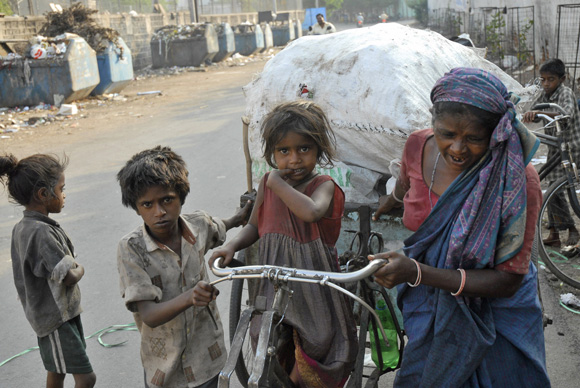
Woman and her children haul garbage in India. Forty percent of India's 1.1 billion people live on $1 U.S. a day. Photo: AP
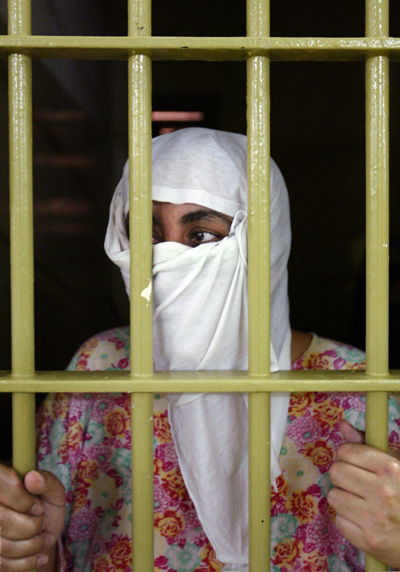
Former school teacher in Abu Ghraib prison, Iraq, 2004. Photo: AP
"Did You Know..."
- Criminalization or stigmatization of abortion forces women to seek abortions under dangerous conditions—creating a situation where 47,000 women die each year from unsafe abortions.
- A girl born in South Africa is more likely to be raped during her lifetime than to learn how to read.
- More than a third of all women in prison in the world are imprisoned in the United States.
- In just the last three years in the U.S., 203 new restrictions to abortion were passed in different states and there are no abortion clinics in 97 percent of rural counties.
- One in three women on the planet will be raped or beaten in her lifetime—that is one billion women.
- In recent decades pornography has become increasingly violent and degrading towards women, even as it has become even more mainstream.
- The average age when females enter into prostitution or pornography in the U.S. is 12 years.

Two hundred people confront the anti-abortion march in San Francisco, January 25, 2014. Photo: AP
Liberating Women, and Fighting for a Whole New World
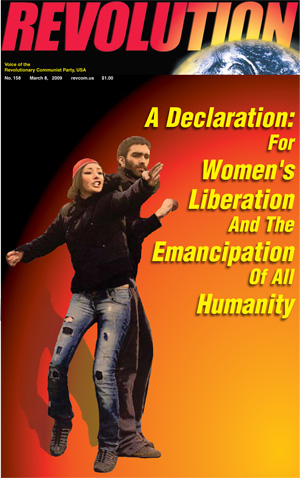
Download the PDF of this pamphlet: A Declaration: For Women's Liberation and the Emancipation of All Humanity
The first socialist societies—the short-lived Paris Commune of 1871, and the radical and far-reaching transformations that took place under socialism in Russia from 1917 to 1956, and in China from 1949 to 1976 were aimed at liberating humanity and ending all oppression. An outstanding element of this earthshaking change was the unprecedented transformation in the status and role of women. For the first time in modern human history, the chains of patriarchy began to shatter, and women were unleashed as a tremendous force for radical change throughout society. (For an in-depth discussion of these revolutions, see the special revcom.us/Revolution issue—"You Don’t Know What You Think You ‘Know’ About... The Communist Revolution and the REAL Path to Emancipation: Its History and Our Future.")
World’s First Socialist State
Pre-revolutionary Russia was a dark and viciously oppressive place for women, crushed by the patriarchal family, the church, law and tradition. But after the old rulers were overthrown in Russia in 1917, the revolutionary state power immediately implemented radical changes that broke the hold of millennia of women’s oppression. Marriage was made secular, and equal. The church-based system of enforced male authority over women and children in the family was abolished. Divorce was made easy to obtain. Equal pay for work was enacted. The Soviet Union became the first country in modern Europe to make abortion and same-sex relations legal. New revolutionary communal and collective institutions gave women the freedom to function as full human beings, even when that meant going up against deeply entrenched tradition. Women were enabled and encouraged to take an active role in all spheres of society, including in government and other leading bodies.
There were struggles against brutally oppressive Islamic Sharia law in Central Asian republics, where the revolutionary state power backed heroic struggles against burkha-like coverings that women had been forced to wear. Open and lively debate over sex roles, marriage, and family took place in the schools and society.
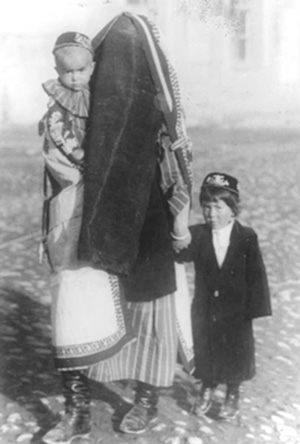

Radical changes transformed Russia after the revolution in 1917. Among them, a major offensive against forcing women in areas dominated by Islamic fundamentalism to wear hijab-like coverings. Above left: A woman before the revolution; right: a young woman in Central Asia after liberation (photo by Langston Hughes).
Revolution in China
In pre-revolutionary China, the status of the vast majority of women was little better than that of slaves. Very young girls were sold by their desperate starving families as “wives” for men of privilege. Millions of women, from the upper classes to prostitutes, had the bones in their feet crushed (“foot binding”) to create what was supposed to be a more “dainty,” sexually-appealling look. Women had little or no legal rights. When the revolution came to power in China in 1949, the masses of people were mobilized to change all that.
New laws banned child and arranged marriages. Divorce was made legal and accessible. Foot binding was ended. The shame was lifted from those who had previously been forced into prostitution, and a new, productive life was opened up for them—in a short time, prostitution disappeared as a social phenomenon.
Social and economic barriers that kept women from being full participants in changing the world were torn down. Mao Zedong, Chairman of the Communist Party that led the revolution, popularized the slogan “Women Hold Up Half the Sky”—a call to fight for the emancipation of women as a crucial part of liberating all of humanity.
While great changes in the role of women took place immediately with the revolutionary seizure of power in China, even more radical changes were needed. The struggle against the oppression of women was a big part of the 1966-76 Cultural Revolution—an unprecedented mass political struggle, led by Mao and other revolutionaries, to beat back attempts by “capitalist roaders” intent on bringing back capitalism, and to further transform all of society. In pointing to remaining influences of traditional oppressive ideas and the need to shatter them, Mao said that unless it was radically transformed, the state ministry of culture "should be renamed the Ministry of Emperors, Kings, Generals, and Ministers, the Ministry of Talents and Beauties or the Ministry of Foreign Mummies." In striking contrast to the way women are portrayed today in culture in the world—as subservient to men in society and in relationships—new works of art and theater portrayed women as daring, strong, and on the front lines of revolutionary change. Women and men in their millions took part in broad campaigns to criticize feudal and capitalist thinking that uphold exploitative and unequal divisions in society and in how people related to each other—one participant in the Cultural Revolution described how, as a young girl, she waged a cultural revolution in her family against patriarchal values and rules.
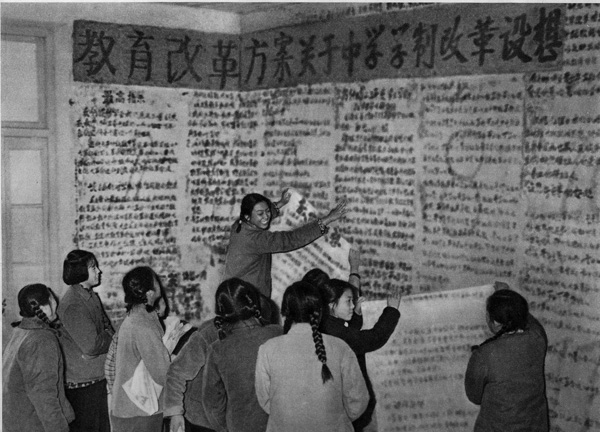
The struggle against the oppression of women was a big part of the 1966-76 Cultural Revolution—an unprecedented mass political struggle, led by Mao Zedong and other revolutionaries, to beat back attempts by "capitalist roaders" intent on bringing back capitalism, and to further transform all of society. Women stepped forward as leaders at all levels, and were supported in doing so. Above, women use big character posters to further political debate and raise consciousness.
Fighting for a Whole New World
This experience was a first step in humanity breaking all the chains of oppression. It included missteps and even serious errors, but it showed that the world does not have to be this way, that there is nothing inherent in human nature that dooms us to this, nor are the forces of the current oppressive world order all-powerful. But the first stage of communist revolution came to an end with the defeat of socialism in Russia in 1956 and in China in 1976.
The world today is deeply and profoundly stamped with the brutal degradation and oppression of women. It is a world dominated by imperialism—of unjust wars, savage poverty and inequality, the accelerating environmental crisis that threatens all life on the planet, and many other outrages. It is a world crying out for urgent, radical change—for communist revolution.
And because of Bob Avakian and the work he has done over several decades, summing up the positive and negative experience of the communist revolution so far, and drawing from a broad range of human experience, there is a new synthesis of communism that has been brought forward—there really is a viable vision and strategy for a radically new, and much better, society and world, and there is the crucial leadership that is necessary to carry forward the struggle toward that goal.
A visionary, as well as very concrete, plan for how the new synthesis of communism would apply to organizing a whole new society exists in the Constitution for the New Socialist Republic in North America (Draft Proposal), from the Revolutionary Communist Party, USA.
There is, right now, a movement for revolution being built right in the heart of the U.S. empire, with the Revolutionary Communist Party as its leading core—a movement that is fighting the power, and transforming the people, for revolution. The struggle against the oppression of women and for the emancipation of half of humanity is a crucial element of this movement.
What is needed is for you, and many others like you, to jump in and become a part of this movement for revolution right now. To stand up to and fight against all forms of enslavement and degradation of women—most especially the intensifying emergency confronting women's right to abortion and the mass brainwashing of society with violent and degrading pornography. To shake off the ways of thinking and relating to each other that this system puts on us, including the message they preach about it being “human nature” that women are dominated and controlled by men. To dig into the theory and spread the leadership of BA and the RCP everywhere. To struggle for the understanding that this is not a fight only for women, but for everyone who is serious about fundamental change. And to do all this as part of building the movement to overthrow all exploitation and oppression and liberate all of humanity. On this International Women's Day, March 8, 2014—stand up and join with protests and other actions around the U.S. and across the world. Break the Chains! Unleash the Fury of Women as a Mighty Force for Revolution!
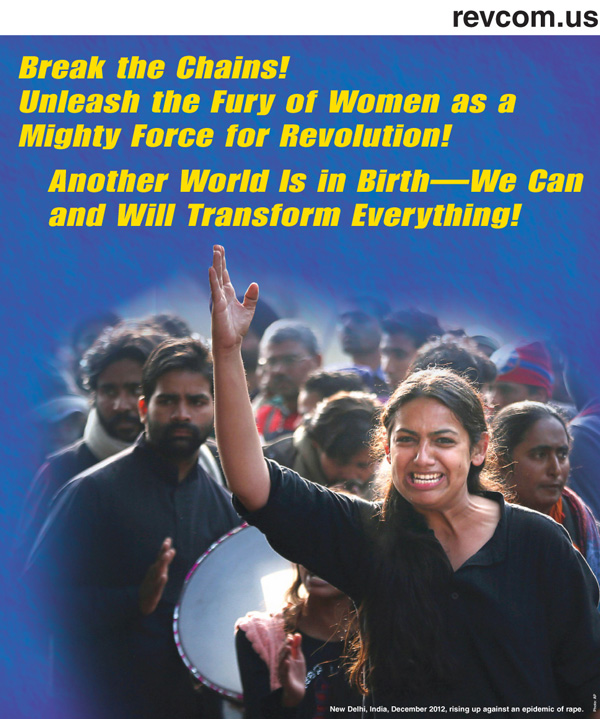
You cannot break all the chains, except one. You cannot say you want to be free of exploitation and oppression, except you want to keep the oppression of women by men. You can't say you want to liberate humanity yet keep one half of the people enslaved to the other half. The oppression of women is completely bound up with the division of society into masters and slaves, exploiters and exploited, and the ending of all such conditions is impossible without the complete liberation of women. All this is why women have a tremendous role to play not only in making revolution but in making sure there is all-the-way revolution. The fury of women can and must be fully unleashed as a mighty force for proletarian revolution.
Bob Avakian, Chairman of the Revolutionary Communist Party, USA
BAsics 3:22
Volunteers Needed... for revcom.us and Revolution
If you like this article, subscribe, donate to and sustain Revolution newspaper.
